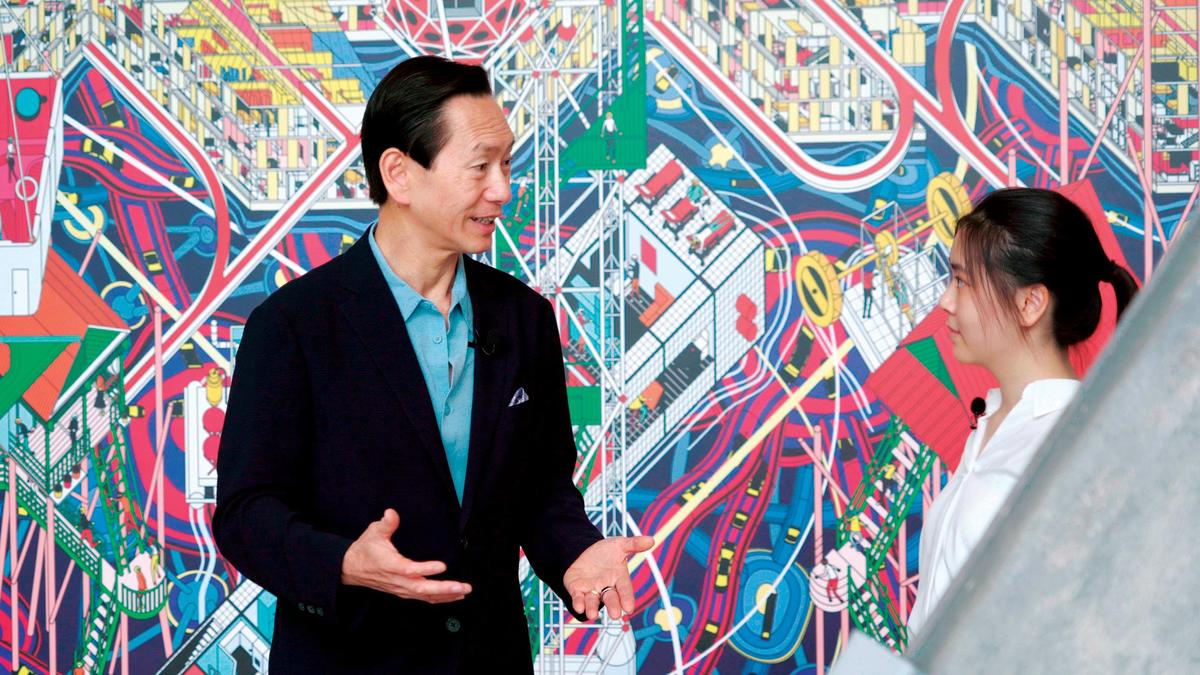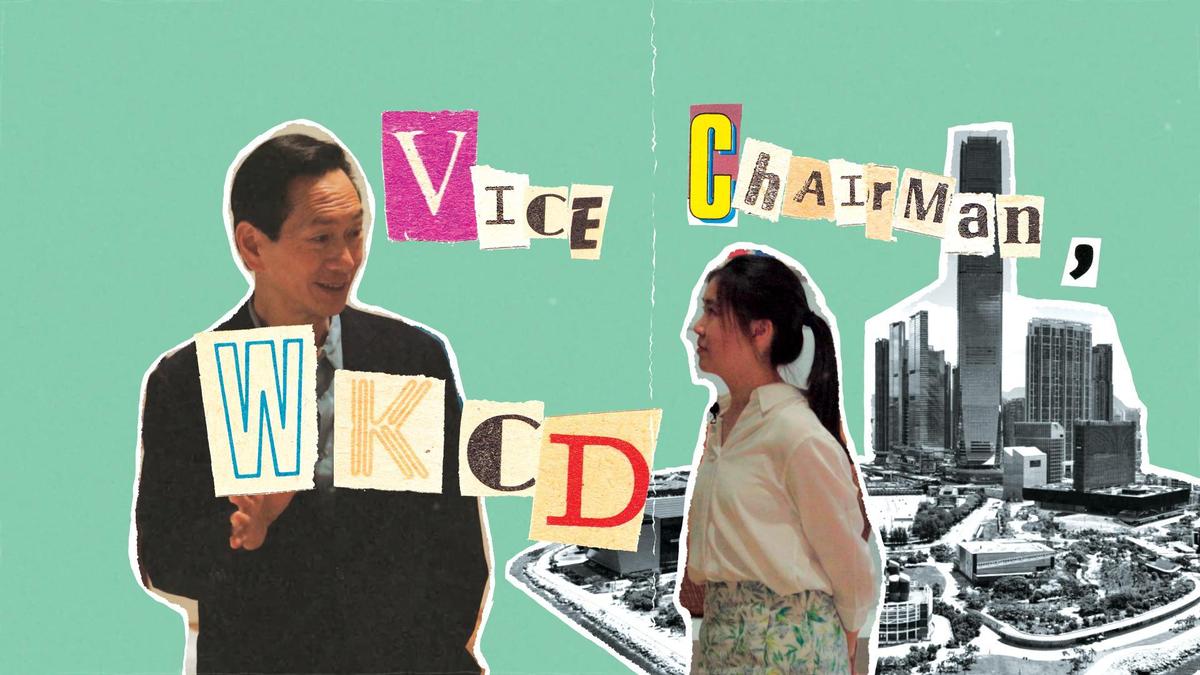Bridging the generation gap
How would the conversation meander between the high-achieving secondary school contest champion, Peony Sham Pui-yan, and high-profile public figure Bernard Charnwut Chan, with an age difference of 40 years between them? Would it be tense? Any worries that the encounter between them would be strained in any way quickly dissipated as the two of them delved into topics ranging from art sensibilities, to life's hard-learned lessons, to hopes and expectations.
Sham - the champion of the Senior Secondary category in the 2023 "21st Century Cup" National English Speaking Competition (Hong Kong Region), organized by China Daily Hong Kong Edition and its education arm VDO English - found her face-to-face encounter with Chan, chairman of the executive committee and vice-chairman of the West Kowloon Cultural District Authority, most enlightening.
The chat, arranged by China Daily Hong Kong Edition, took place in a spacious room in the WKCD's M+ museum, with sound reverberating within the space and with floor-to-ceiling windows looking out onto Victoria Harbour, mirroring the ideas, vision and energy emanating from the chat.
When at an age similar to Sham, Chan was a college student majoring in studio art, as well as a painter, who had never envisioned being at the helm of Hong Kong's art and culture scene someday. It was inconceivable three or four decades ago that the city would today emerge as the gem of East-meets-West culture.
"We've always been a financial and business hub. But, for art and culture, we would hardly consider it as something we'd be proud of. Even with a degree in studio art, I thought this would never be my career," recalls Chan.
Chan's foray into art had happened through serendipity, and he believes this was a twist that life had set up for him - a blessing in disguise that has ended up defining him as a charismatic personality.
While Chan initially studied economics, poor health at a relatively early age took a toll on him and his studies fell by the wayside. "I had to stay off the campus to recover from several surgeries. But I didn't want to miss out on school and the credits. So, looking through the syllabus and trying to figure out what classes I could take while I was off campus, studio art came up," he reminisces.

From shadow to light
Becoming a graduate with an art degree was a hand-wringing experience for Chan, whose parents' generation had dismissed art as nothing but ephemeral and unsubstantial, and who thus felt a certain amount of shame about his decision. "I was quite intimidated to tell anyone I was a studio art graduate because, as you can imagine, the first thing people would say was, 'Why?' " Instead of fielding questions and rolling his eyes, Chan decided to sweep it under the carpet. "I lied to them (and claimed) that I'd studied business," he says with a wry wit. "I felt I wasn't good enough, and I had to justify my decision. I was just tired of it."
It wasn't until Chan entered the public sector that his art degree helped bring light into his life. In the SAR's first Legislative Council Election held in 1998 - a year after the handover - Chan, then a 25-year-old graduate, was elected as the city's youngest lawmaker among 60 council members.
"LegCo's Madam President summoned me and told me: 'You're the only one among the 60 members with a degree in art'," Chan recalls. This validation of his art qualification took him by surprise, but also made him question the remark's authenticity. "Maybe she thought I wasn't good enough. Or she wanted me to give up politics or legal matters. I guess I should say this."
But it turned out the LegCo president truly meant it. "She said to me: 'Now that Hong Kong has returned to the motherland, it's the first time we have our own Legislative Council and we need a new logo for it.'" Instead of expecting Chan to design a logo, which he would have found impossible, the council president asked him to find a designer to take charge of the design.
It seemed art had become Chan's inescapable destiny, and he wasn't sure if it would do him a disservice, or open a way for him to enter public service.
If the task of getting the logo designed was too trivial to launch Chan into the art and cultural sphere, another opportunity soon arose that would catapult him into uncharted territory and prod him into taking the driver's seat in art and cultural management for the SAR.
He was approached by the SAR government again, and this time he was asked to take charge of the city's heritage conservation. Chan was talked out of his fear of inadequacy and was told he was the "closest candidate we can think of because we need someone who appreciates the aesthetic", Chan recalls.

Shift in attitude
Gripped by Chan's story of this bumpy journey that eventually propelled him into the world of art, Sham - currently at crunch time for her university admission application - says she believes society's perception of art graduates and creative types has changed.
What she gets from Chan in return is music to her ears. "The society has changed dramatically," he agrees with her. "While some stereotypes remain, I find parents today far more receptive to their children's artistic pursuits."
The paradigm shift in attitudes is generational, partly through exposure and education, but also due to the self-sustaining art and cultural ecosystem Hong Kong has been nurturing.
Museums, galleries, auction houses and theaters are not standalone fixtures in Hong Kong, but each gel with the other and coalesce into a regional prowess that speaks volumes about the city's well-orchestrated art and cultural milieu - which is anything but exclusive for its 7 million residents, says Chan.
"We're attracting the best performances and the best cultural displays to Hong Kong. At M+, for instance, we have the largest Chinese contemporary art collections here. We distinguish our Palace Museum from its counterpart in Beijing by infusing Hong Kong's (unique) curatorship, our own approach."
The ecosystem is not complete without artistic talent, notes Chan. "We've never had the need to train such type of people in the past (before Hong Kong had stamped its name on the global art and cultural map)." So, the city has had to catch up with spotting and nurturing its art talent in sync with the established hardware. This suggests that following the path to an art career is now welcomed and even coveted in Hong Kong.
The swelling ranks of the rising middle-class in the Association of Southeast Asian Nations region, with a population of half a billion people, have an affinity and a fervor for art investment, quality performances, and premier art shows and exhibitions, which means there is a gargantuan consumer market for Hong Kong's art and culture, notes Chan.
'Keep options open'
It seems that in the increasingly globalized climate, cultures, industries and skills have all become porous. There are less clearcut definitions for each discipline, yet there is more fusion, compatibility, and collaboration with different skillsets and expertise. That's the point Chan's trying to drive home: "Always keep those options open!", and "Don't box yourself into any specifics. You can still be in those (traditionally highly regarded) professions, as say a doctor, lawyer or financier but, at the same time, you can be involved in art curatorship. Or, if you get into the legal field, you can be a lawyer specifically to do with art," says Chan.
The rigid lines that used to define and separate different disciplines have become fuzzier, with more overlapping skills, which, Chan believes, creates infinite opportunities and possibilities for the young generation, who can pursue careers in areas "beyond so-called 'white-collar jobs' ".
Describing herself as an art aficionado who enjoys performing arts, musicals and shows, Sham asks: "How can we encourage more young people to develop an interest in and an appreciation of the arts, but not necessarily as a career?"
It's not the arts as a profession that needs a facelift, but rather the training of people to appreciate the arts, plus greater exposure to the arts, that would furnish them with aptitude and wisdom that can be grafted onto other fields in which they aspire to succeed. This is Chan's core message to young people.
"I find what I've learned from studio art training applies in my business world, sometimes, even in politics. It allows me to think outside the box - the same with music. You don't have to be a fantastic musician. But, as a repetitive exercise, it teaches you discipline, consistency and diligence, which are valued in your later career," explains Chan.
Related articles
-
 Master's works bring modernity to traditional painting
Master's works bring modernity to traditional paintingMore
-
 Exhibition showcases million-year human history of China
Exhibition showcases million-year human history of ChinaMore
-
 New art center's inaugural show a salute to Chinese expressionism
New art center's inaugural show a salute to Chinese expressionismMore
-
 Bridging the generation gap
Bridging the generation gapMore
-
 Exhibition offers a captivating insight into photographer's exploration of western China
Exhibition offers a captivating insight into photographer's exploration of western ChinaMore
-
 Exhibition showcases six generations of He family's masterpieces in Wuhan
Exhibition showcases six generations of He family's masterpieces in WuhanMore
